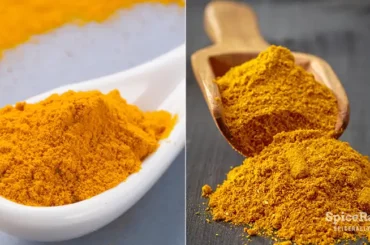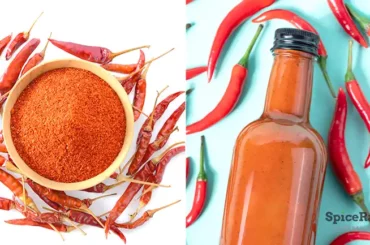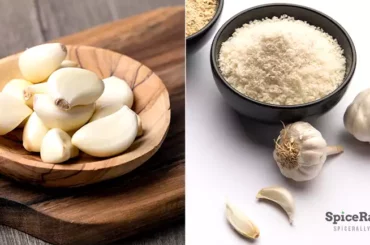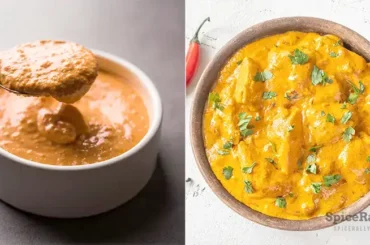Indian cuisine is reputed for its variety of spice blends. But each one is different from one another, at least distinguished by a single feature. So, let’s discuss all you need to discover about sambar powder vs Garam Masala.
Sambar powder is specifically used in making sambar curry, but Garam Masala is much more versatile than that. Most importantly, sambar powder usually contains toasted lentils and red chiles, while we don’t see toasted lentils in Garam Masala. And traditional interpretations of Garam Masala do not typically include red chiles, while some variations might do.
Read along to learn in what other ways these two spice blends differ and compare.
Sambar Powder vs Garam Masala Powder- SpiceRally DrillDown.
| Sambar Powder | Garam Masala | |
|---|---|---|
| Base flavor | Spicy and warm | Spicy and warm |
| Main ingredients | Red chiles Chana dal Toor dal Urad dal Turmeric powder Coriander Curry leaves Mustard seeds Cumin Black peppercorns Fenugreek seeds It might also include the following: Coconut Salt (occasional) Asafoetida | Green cardamom Black cardamom Mace Coriander seeds Cinnamon Bay leaves Cloves Cumin Nutmeg Black pepper Fennel seeds You’ll find many variations of Maram Masala depending on the region and household, and these variations might include the following: Garlic Caraway seeds Star Anise Ginger Kashmiri Red Chili |
| Flavor Profile | Sambar powder has a greater depth than Garam Masala due to the inclusion of lentils. This blend can also be hotter but less spicy than Garam Masala, with earthy, savory, and warm flavor notes. | Possess a spicier flavor profile than sambar powder. But it can be less hot and have a milder depth than sambar powder with robust, warmer, and earthier flavor elements. |
| Heat and spiciness | More heaty but less spicy than Garam Masala | Spicier but has less heat than sambar powder |
| Texture | Somewhat coarser than Garam Masala. | A fine, pulverized mixture that has a more refined texture than sambar powder. |
| Color | Lighter and more yellowish than Garam Masala. | Deeper in color than sambar powder, ranging from light to dark brown in shade. |
| Mode of usage in cooking | As an ingredient | As an ingredient and a finishing spice in many dishes |
Click on this and follow up on this post to learn about sambar powder in detail!
| Usage in cooking | – Mainly used to make Sambar Curry – Is incorporated in gravies and curry sauces. – Flavors certain Indian-style rice dishes. – Used to make other vegetable and lentil curries. – Flavors rubs and marinades made for fish and meat. | – Widely used with meat and fish curries – Flavors Indian-style egg recipes – Added to a variety of ground meat recipes – Adds depth to vegetable dishes – Incorporated into rice dishes |
| Variations | A lot of variations don’t exist. Often clings to a similar recipe. | Many variations exist depending on the household, production, and region. |
| Origin | Indian cuisine | Indian cuisine |
| Availability | Available under several brand names in supermarkets, online shopping sites, and Asian groceries. | Can be purchased under a large variety of brand names from grocery stores, Asian groceries, supermarkets, and online sellers. |
| Storage | Most pre-packaged sambar powder options can be kept outside with the rest of your dry spices or seasoning in a well-fitting glass jar. But it is advisable to store coconut-included homemade sambar powder in the refrigerator to have a longer shelf life. | Once used, store in a glass, tight-fitting spice jar/container in a dark, dry, cool place. It can be stored in your spice cabinet with the rest of your dry seasonings/ spices. |
| Mode of production | Commercially made and homemade variants exist. | Commercially made and homemade variants exist. |

Elaborating On The Difference Between Sambar Powder And Garam Masala.
Garam Masala and sambar powder are not unfamiliar to Indian households as you might see these two blends as staples in almost every Indian kitchen. Sambar powder is widely used across south India, while Garam Masala is more universally known even in Western cuisine. However, the key difference between sambar powder and Garam Masala comes down to their ingredients.
Both are rich in spices but with different flavor profiles. Toasted lentils are a prominent feature of sambar powder which is accountable for its rich texture and depth. Garam Masala, on the other hand, does not feature any type of ground lentil. In addition, sambar powder contains a decent amount of dried, roasted red chiles.
But, traditional Garam masala does not have red chiles, while you might find this spice occasionally in some variations. Nevertheless, Garam Masala contains a lot more spices than sambar powder, largely varying depending on the household, region, and production.
But sambar powder does not range much and tends to stick to the same group of ingredients most often. Accordingly, we can say that sambar powder is warm, spicy, and possesses a considerable amount of heat. But on the contrary, Garam Masala is spicier but might often lack the hotness you typically savor in sambar powder.
Similar Reads…
Difference In The Usage
Owing to the variety of ingredients used in Garam Masala, it is prized as a spice blend that can complement a wide range of dishes. It doesn’t mean that sambar powder is incapable of pairing with many foods.
But, it holds a milder flavor profile and is primarily tailored to go well with vegetables and lentils. Thus, the chances are high that you would find more versatility in Garam Masala than with sambar powder in daily cooking.
Can I Use Sambar Powder In Place Of Garam Masala And Vice Versa?
Despite the fewer differences, both spices blend roots from the same cuisine and share similar cultural aspects. And above all, sambar powder and Garam Masala share a lot of similar ingredients. Therefore, there’s the possibility to use sambar powder in place of Garam Masala and vice versa.
However, you should always keep in mind that both of them would not give the same effect that each one of them initially gave. Hence, it is essential to consider substituting them in place of one another only if these spice blends feature as a secondary element in a particular recipe.
For example, Garam Masala in Sambar Curry will completely change the nature of the dish. Things can work the same way if you use sambar powder instead of Garam Masala in recipes like Mutton Keema or Garam Masala Chicken Curry.




